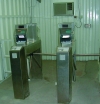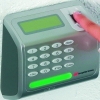
From the hand reader at the front door to the finger scanner securing the pharmacy, biometric solutions are becoming ubiquitous in large-scale installations.
If you think biometrics are only suitable for extremely high security applications, or relatively small user populations, think again. Today's biometric solutions are cost effective, secure, and convenient for large user populations, medium-security applications and large-scale installations. Finding the right biometric for the application is key, and that may mean using two different biometric technologies for the same installation. In today's world of ever-increasing security, biometrics is fast becoming the security standard to follow rather than the high-security exception for access control and time and attendance applications.
As integrators and end-users learn which biometric technology to use within each installation, biometrics will grow even faster. Hand readers and fingerprint readers constitute 80% of the biometrics market for access control and time and attendance applications. More and more, these two popular biometrics are being used to meet different needs in the same installation. For example, a Wisconsin medical centre uses hand readers for access control at its main entrances and fingerprint scanners to secure individual labs with fewer users.
Moreover, one might expect to find biometrics in ultra-secure environments such as airports and nuclear plants. However, they are being commonly used in very low-tech facilities such as health clubs and spas to avoid the problems and fraud of card-based systems. They are also increasingly being used in large-scale installations at medium-security facilities such as universities, large school districts and hospitals.
Building on biometrics in Macao
Solution Expert Technology of Hong Kong implemented a biometric-based system using 90 hand readers to control access to all six entrances at a construction site that has ultimately become the Venetian Macao, the anchor of a Las Vegas style strip for Asia.
"Protecting projects from theft and keeping people from getting hurt on construction sites are always a top concern," explains Tony Yuen, COO of Solution Expert Technology. "In Macao, strict labour and safety laws that prevent illegal workers, and workers without safety training, from entering construction sites make strict access control even more urgent. General contractors who violate these laws receive heavy penalties when they are caught."
According to Yuen, contractors are increasingly turning to biometric hand geometry technology to help them quickly give access to authorised workers and accurately deny entry to people who should not be on site. With hand readers, a worker's permit and safety training records, along with expiration dates, can be entered into a database that not only verifies an employee's identity, but instantly checks to see if that employee is authorised to be there.
Hand readers automatically take a three-dimensional reading of the size and shape of a hand and verify the user's identity in less than one second. At the Venetian Macao, the site is so big that there were concerns that cables would be consistently cut so data is sent wirelessly, using an 802.11 wireless router.
Solution Expert Technology has written time and attendance software for both Chinese and English users that interfaces seamlessly with the hand readers. Similar systems are used at more than 100 construction sites operated by several of the largest construction companies in Hong Kong.
At the Venetian Macao site, turnstiles are posted at each entrance. They create a dual system with HandReader terminals on both sides, allowing the same turnstile to be used by workers either entering or exiting a site. A contactless smartcard, typically kept in a hip pocket, calls up a stored biometric template, which is then immediately validated by placement of the employee's hand on the HandReader terminal. Timekeeping information for the employee is instantly transmitted to a central office wirelessly. Everyone entering the site, from employees to outside subcontractors and vendors, is required to use the hand readers for access.

Smartcards open even more doors
The migration to smartcards will induce many new opportunities for users and installers of biometric solutions. For instance, a smartcard can store both the user's ID number and hand geometry template on the card. Because of this, there is no need to distribute hand templates across a network of hand readers or require the access control system to manage biometric templates. This means integration to any existing access control application is greatly simplified and additional network infrastructure costs are eliminated. Since the template only resides on the card, the solution also eases individual privacy concerns.
Providing the best of smartcards and biometrics, the solution provides dual authentication by requesting both the right card and the right person. A smartcard reader is embedded into the biometric reader. A plastic cardholder is affixed to the side of the unit.
In most applications involving smartcards and embedded biometrics, hand geometry is preferred since a hand template uses up only 9 bytes versus an average of 300 bytes required by fingerscan readers per finger.
When the smartcard is presented to the smartcard reader embedded in the biometric reader, the user is requested to place their hand or finger on the reader, which then compares the read with the template stored in the smartcard to verify identity. The process takes approximately one second and is virtually foolproof.
Biometric manufacturers offer a variety of different methods to integrate biometrics into conventional access control systems. The most common way is 'card reader emulation'. This method is very effective when integrating into existing card-based systems to bring extra security to the front entrance or server room. The wiring is identical to the card reader's wiring.
In this mode, the biometric device essentially works with the access control panel in the exact same way that a card reader does. The 'card reader output port' of the biometric is connected to the panel's card reader port. When a person uses the biometric, it outputs the ID number of the individual if, and only if, they are verified.
The format of the output is consistent with the card technology used by the access control panel. Once an ID number reaches the panel, it is handled as if it came from a card reader. The determination of granting access is made by the panel. The access control panel, not the biometric, handles door control and monitoring.
But... which biometric?
Fingerprint readers complement hand readers by being a low-cost biometric that is best used on doors accessed by less than 100 people. In these applications, the total number of transactions tends to be fairly low. Therefore, issues generated by the higher error rates exhibited in fingerprint technology ends up being a minor inconvenience rather than a major hassle. Yet, adding the biometric technology provides a huge increase in security over a 'card only' system.

For these low volume openings, cost is a key consideration and fingerprint products meet that need. For instance, a fingerprint reader is ideal for a lab area accessed by 10, 20 or 30 people. This has been a major growth area for fingerprint products. They will also squeeze into small areas, like at the door to a medical cabinet. They are best when used indoors.
By using both biometrics, customers and integrators can mix and match hand readers and fingerprint readers within the same facilities, ensuring the best combination of cost and technology is implemented at every door.
Biometrics: a global phenomenon
There is an unparallelled list of successful biometric implementations across the globe and its varied applications are reflected in the diversity of its users. From McDonald's restaurants in Latin America to Ben Gurion Airport in Israel to Hong Kong and Macao construction sites, biometrics are finding an enthusiastic audience in both the time and attendance and security sectors. Whether the application is for maximum security, or for maximum flexibility or convenience, biometric technology is providing access for a virtually endless variety of uses.

If there has been one major impediment to biometrics growth, it has probably been the tendency to view all biometrics as equal. Against such a belief, too often people have used the wrong biometric technology in the wrong applications. In some cases, the sales went to the biometric that cost the least. In other cases, manufacturers have only had one biometric to tout, so this is understandable. However, with the advent of biometric manufacturers offering more than just one technology, end users will finally be able to trust that each biometric selected is the right biometric for that access point.

© Technews Publishing (Pty) Ltd. | All Rights Reserved.